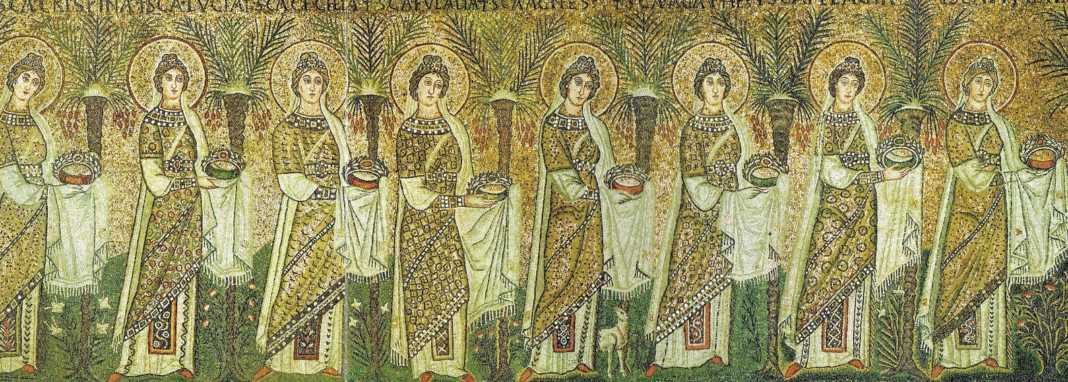By: Catherine Tsounis, contributing editor
Mosaics are amazing in Ravenna. Women and their influence are scenes in the Byzantine mosaics. “Women never betrayed their identity as guardians of life, because none of them has been an accomplice to the crucifixion of Jesus (not even Pilate’s wife),” explained Lorenzo Ghizzoni, Archbishop of Ravenna-Cervia. “They had the courage to remain at the foot of the cross until the very end, because a women’s love can overcome fear for her own fate…. The church is born only if women believers can contribute.” I find this viewpoint of the importance of women inspiring in 2020
Mons. Guido Marchetti, Director of the Opera di Religione, diocese of Ravenna, said “The mosaics in Ravenna portray, narrate and extol women of great faith, leading protagonists genuine “Bright Stars of both the Church and Society.”1
In the Basilica of St. Vitale is a mosaic of Sarah with Abraham. She portrays strength and faithfulness. Late in life she had a son, Isaac. The “Praying Mary” mosaic shows her draped in purple, the garments of royalty in the mosaic hall of the Archiepiscopal Museum. The mosaic of St. Apollinare Nuova shows an enthroned Mary, connected to the public life of Jesus. “The Procession of Virgins” mosaics at St. Apollinaire Nuovo shows respect towards courageous women, even if it was part of an Arian Christian faith by King Theodoric. These are mosaic masterpieces to be treasured.
“I know it’s the belief that women should never show daring in front of men. Never be bold when men hesitate. I know flight is not the answer; even to save our lives,” said Empress Theodora of the Eastern Byzantine Empire. The Theodora Mosaic in the Basilica of St. Vitale in Ravenna, Italy shows her in imperial Roman garments with Antonia and Ioannina, wife and daughter of General Belisarius. Empress Theodora is are dressed to identify herself with the saints and prophets. The Theodora mosaic establishes her eternal presence among the divine. Empress Theodora built St. Vitale in the 6th century. The Basilica is considered a masterpiece of Byzantine architecture. St. Vitali Basilica is one of the 25 churches constructed by Justinian and Theodora, including the Hagia Sophia. Empress Theodora may have done more than any ruler in the ancient world to promote the status of women.
Roman Empress Galla Placidia is associated with Ravenna. Galla Placidia (386 – 450 AD), sister of the Roman Emperor Honorius who had transferred the Capital of the Western Empire from Milan to Ravenna in 402 AD, built this little Mausoleum with a Greek cross plan around 425-450 as her own resting place. However, the mausoleum was never used for that purpose. The Empress died and was buried in Rome in 450.2The mosaics are made of smalti, colorful glass and 24k gold metal leaf.
Ravenna remains the most important site of Byzantine art outside Constantinople. The mosaic artist became the illustrator of a series of incidents for the benefit of an illiterate people. When we discuss the “Women of Ravenna” in mosaics, we refer to Mary, Mother of Jesus, figures from the Old and New Testaments of the Bible. The two empresses, Galla Placidia and Theodora’s religious monuments help make Ravenna what it is today. I am very happy I had the opportunity to visit Ravenna, a gift to Western Civilization, in 2017 before the coronavirus epidemic.
Photo– Procession of Virgins, St. Apollinare Nuovo





